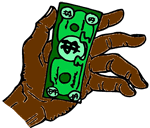What Face do you Use?


The students will recognize that in order to facilitate the exchange of goods and services, most nations create currency for use as money. They will examine the characteristics of money by comparing and contrasting examples of U.S. and world currencies. Imagining that their classroom is a country, students choose whom to honor and what images to depict as they create their own form of paper money.
Introduction
 Explain to the students that money is very important. It is what people use to give value to goods and services, and it’s the best way for people to get the things they want.
Explain to the students that money is very important. It is what people use to give value to goods and services, and it’s the best way for people to get the things they want.
To introduce the concept, hold a pretend auction for a week’s worth of "homework passes." Ask the students what they would trade you for the passes, telling them they cannot offer money. After taking a few offers, ask the students to discuss as a class why it would be difficult to make trades in this way. [Different people place different value on items such as the things they may have offered you, but money is a widely accepted form of exchange that has a specific agreed-upon value.]
Tell the students that most countries create currency for use as money, and today, right here in class, they are going to do the same thing!
Learning Objectives
- Recognize that in order to facilitate the exchange of goods and services, most countries create their own currency for use as money.
- Examine the characteristics of money, and then compare and contrast examples of U.S. and world currencies.
- Choose individuals and imagery to be depicted on currency they create.
Resource List
-
AmosWEB: AmosWeb definition for "characteristics of money".
www.amosweb.com/cgi-bin/awb_nav.pl?s=gls&c=dsp&k=money%20characteristics
-
U.S. Bureau of Engraving and Printing: Interactive images of United States money currently in use.
newmoney.gov/newmoney/flash/interactivebill/5_InteractiveNote.html
-
Mappage: Excellent resource for images of different currencies from around the world.
https://www.banknoteworld.com/
-
Collect Paper Money: Information on the standard features of paper money.
collectpapermoney.com/banknote.asp
-
A World of Money: This interactive activity test students knowledge on currency and shows them currency from around the world.
A World Of Money
-
Biography of James Madison: A page with information on James Madison, one of the Founders singled out in the interactions section of this lesson.
www.whitehouse.gov/history/presidents/jm4.html
-
Sacagawea Golden Dollar Coin: A page with information on Sacagawea and the Sacagawea dollar recently introduced.
https://www.usmint.gov/learn/coin-and-medal-programs?action=golden_dollar_coin
-
H.I.P. Pocket Change: This website allows students to create their own coins.
https://www.usmint.gov/learn/kids/games/making-change
Process
[NOTE: The benefits of this lesson are twofold. In the short term, the students should understand why money is important, and what goes into creating a currency that will be useful. In the process of their work, they should very much enjoy the opportunities for creativity and personal expression the lesson provides. In the longer term, there are a many possibilities for a class that has its own currency. The currency can be used for incentives and rewards, buying and selling activities, games, events, etc. It could even be used as the means of exchange for a class-wide “mini-economy,” facilitating the process in economics-related events and lessons taking place periodically throughout an entire school year.]
As you determined in the introductory activity, money is useful for a lot of reasons. It can help you buy goods (things you want or need) or pay for services (things people do for you). It does this by providing a common, agreed-upon exchange value. Most countries have a form of paper currency for use as money.
Ask your students: If you classroom were its own country, what would its money be made of?
To explore the possibilities, ask the students to look at different types of paper money.
-
Have the students visit the AmosWeb site to find out about characteristics of money such as durability, divisibility and portability. The students can search for each term or use the alphabetical browse menu to find them. Ask:
-
Define each term:
- Durability
- Divisibility
- Portability
- Why are these factors important?
- How will you be sure your money is going to last?
- How can you make the denominations work so they are easy to figure out?
Tell the students: Once you decide on the materials and denominations, you'll need to decide what your currency will look like.
-
Define each term:
-
Compare and contrast U.S. money with https://www.banknoteworld.com/ from around the world. Examine the characteristics (pictures, symbols, color) of money. Ask:
- What kinds of pictures are used?
- Why do you think a country chooses the pictures it does?
- What other information is included on currency aside from symbols and/or pictures?
- In your research, find one way in which countries try to prevent people from copying, or "counterfeiting," their currencies.
[Common choices for images on currency include: portraits (figures from the country's history, such as politicians, artists, military figures or scientists; pictures of important places and buildings; pictures of a product produced in that country, such as wheat or sugar cane. Basically, the images on currency represent aspects of that country. Other items that are included are value amounts, information about the issuing agency, and legal information.]
-
Tell the students that they are going to print original paper money, which they will use for various activities throughout the year. Tell the students they will first have to decide what kind of material, what divisions they will use and how the design will look. Ask: How will you decide?
- How will you make sure the money will last?
- How will you make your money so that it is easy to make change for people?
- Will you choose pictures that represent your class in some way?
- Will you choose pictures that represent your town, or state or country?
Tell the students to write down all of their ideas.
[NOTE: Grouping the students for this brainstorming activity is at your discretion. You may allow students to brainstorm individually or to work in small groups, or you may lead the entire class in a discussion of the possibilities.]
The students may have many different ideas about what images to include and/or what style/s to emulate.

- Figures from politics today–like the President, Secretary of State, National Security Advisor, etc.
- Favorite sports figures.
- School figures–such as the teacher, the school principal, classmates, the school mascot, etc.
- Important buildings in town–such as city hall, local landmarks, or the school.
- An image of an important product produced nearby, or a picture of something else for which the town or state might be known.
- A flower or tree that grows locally.
- A type of animal that lives in the area.
- American currency has portraits of the Founders of our country on the obverse and pictures of important buildings or events on the reverse. Some students may recommend using images of the same Founders who are on United States currency today.
-
At the following site the students can take a look at other features of paper money . Ask:
- Besides pictures, what other items are shown on currency?
- Why is it important to show these items on money?
Following this discussion, the entire class must make a final determination of the form its currency will take. Analysis, criticism, further brainstorming and other techniques may all be necessary to arrive at prototypes for the various denominations to be created. Moreover, the process for determining what elements will be included in the final products is at your discretion. You may allow a vote or decide by lottery, or you may select the best options yourself. In addition to discussion of the elements to be included, you may choose to include the class in a determination of the art media to be used.
After you complete this process, distribute the requisite art supplies.
-
Time to make your money! You can use this website to create your https://www.usmint.gov/learn/kids/games/making-change .
This is where your students will create their classroom currency. Provide them with plenty of tools (paper, markers, crayons, etc) to do so. The 'micro-national classroom sovereignty' aspect of this exercise will likely be fairly engaging for all students, as it offers them the opportunity to use their own creativity and their personal views about what is important in the task at hand. However, if you notice a student who is less than fully engaged, consult privately with that individual in order to learn what might be holding him or her back.
In the Compare and Contrast activity, students will need to switch between windows in order to view the images they are analyzing. Some students may not be adept at the technique of switching between windows and may need a brief refresher.
Conclusion
Ask the students to consider these questions:
- How can you use your new currency to win the homework passes we had for auction at the beginning of the lesson?
- How well do you think your new money represents your class?
- How does it compare to United States currency, or to other currencies from around the world? Is it durable? Portable? Will you be able to divide it easily to make change?
- What one characteristic is your money missing that prevents you from using it outside the classroom? [Acceptability: This money will only be recognized by the members of the class.]
So, now that your class has its own form of currency, what will you do with it? Any ideas? [Elicit suggestions as to how the students’ play money might enhance their learning experience throughout the year. Perhaps you can set up a market, or put on a show for other classes and sell tickets.]
Extension Activity
-
Want to learn more? Have fun and show what you know by playing the A World Of Money game.
-
We are all familiar with the Founders on today's money, but would you choose any other figures from United States history? Perhaps you feel that James Madison should be on a bill. After all, he helped write the Constitution and the Bill of Rights, and he was president when we won the War of 1812. Do you think he should be on a bill? What about other figures from our history?
- The United States Treasury did decide to honor another figure from American history recently–a woman named Sacagawea. Do you know who she was? Use the following link to learn more about the https://www.usmint.gov/learn/coin-and-medal-programs?action=golden_dollar_coin.
Assessment
Engage the students in a "thumbs up – thumbs down" activity. Hold up several different items (such as a piece of fruit, a bag of marbles, a weight and other items from around the classroom). Ask the following questions for each one, and observe students’ responses to each question:
- Would this be durable as a source of currency?
- Would this be portable?
- How easy would it be to divide this?
- Could you use this at a store of value?
In addition to the questioning activity, you should observe the students’ participation in and contributions to the discussion and decision-making process. In the course of this process, students are producing written accounts of their brainstorming process. These may be assessed for thoroughness, creativity, flexible thinking, and other criteria. The nature of the final product may also considered and assessed for a number of criteria, including its attractiveness, neatness and the degree to which it pays attention to the necessary characteristics of money–and adheres to the original concept, as determined by the class.
